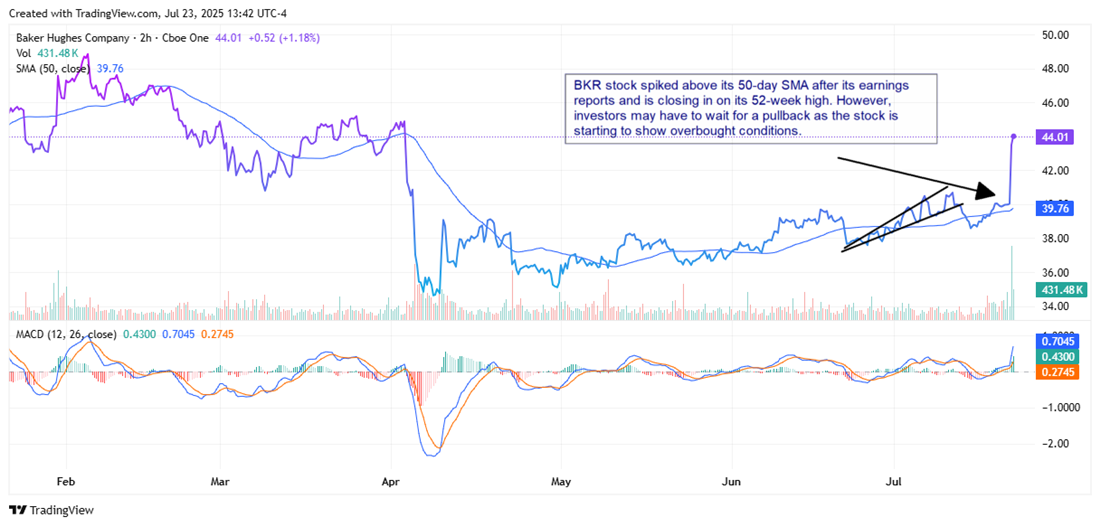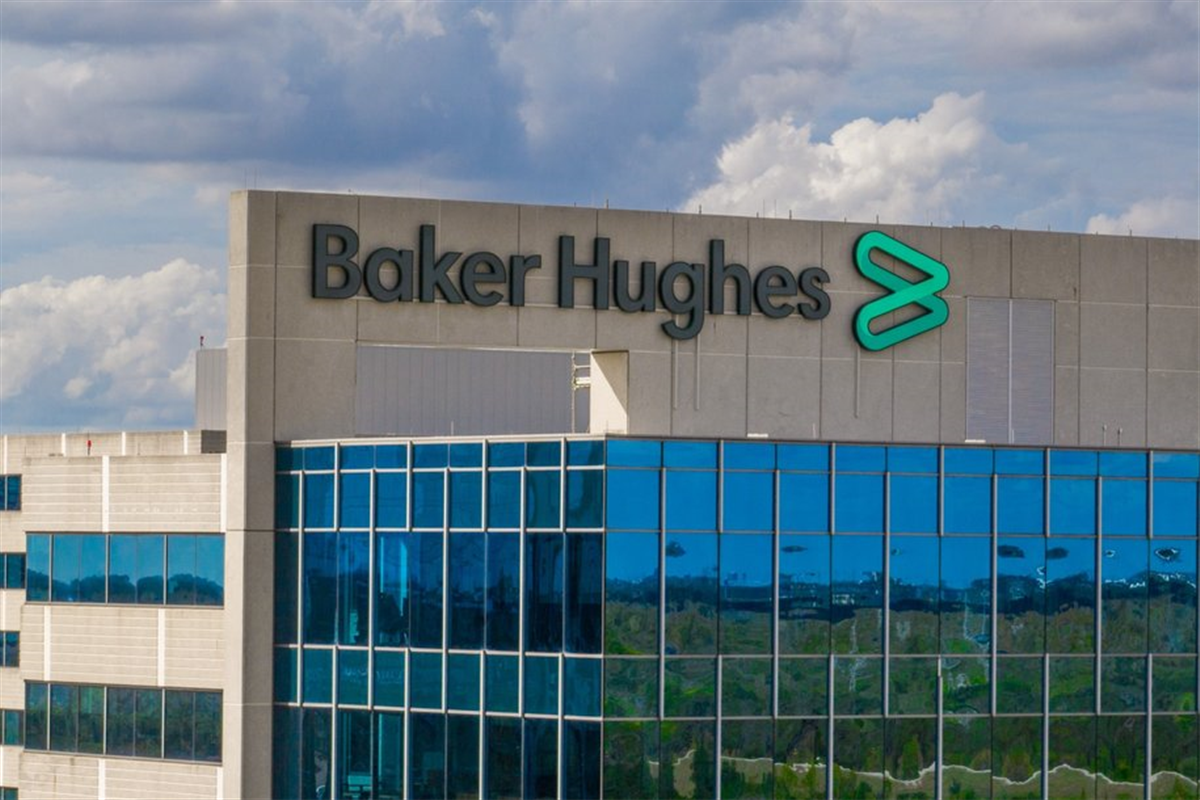Baker Hughes Today
As of 07/25/2025 04:00 PM Eastern
- 52-Week Range
- $32.25
▼
$49.40
- Dividend Yield
- 2.00%
- P/E Ratio
- 15.05
- Price Target
- $49.50
Baker Hughes NASDAQ: BKR won’t be a name that comes to mind in the context of rising global defense budgets. However, the company’s recent earnings report shows why Baker Hughes may have an unrealized advantage as energy infrastructure, digital automation, and drone warfare become increasingly interconnected.
Baker Hughes is best known as a provider of energy and oilfield services. That makes the company’s earnings and stock price sensitive to the price of oil and natural gas. A closer look at the company’s earnings report shows how it continues to transform itself into a technology-driven industrial player.
Specifically, Baker Hughes is building adjacent capabilities in digital infrastructure, industrial AI, and process optimization. These are assets that could quietly align it with next-generation defense priorities.
Defense Spending Will Increase to Meet New Threats
After the passage of the Trump administration’s “One Big, Beautiful Bill,” the U.S. defense budget for fiscal 2025 will exceed $900 billion. That dollar figure is impressive, but it’s where those dollars will be allocated that may be more significant to Baker Hughes.
The U.S. Department of Defense (DOD) intends to make significant allocations toward unmanned systems (e.g., drones), energy resilience, and digital warfare. That has many investors looking to traditional defense contractors like Lockheed Martin Corp. NYSE: LMT and Northrop Grumman Corp. NYSE: NOC. However, to accomplish its objectives, the DOD will have to turn to industrial technology providers to source advanced capabilities in the energy space.
Baker Hughes’ Strategic Pivot: More Tech, Less Cyclicality
This is where Baker Hughes may fit in. Like most energy stocks, Baker Hughes has had an “okay” year. BKR stock is up about 6.8% year-to-date. However, the stock jumped over 9.5% after its second quarter earnings report.
Baker Hughes MarketRank™ Stock Analysis
- Overall MarketRank™
- 84th Percentile
- Analyst Rating
- Moderate Buy
- Upside/Downside
- 7.5% Upside
- Short Interest Level
- Healthy
- Dividend Strength
- Moderate
- Environmental Score
- N/A
- News Sentiment
- 0.96
- Insider Trading
- Selling Shares
- Proj. Earnings Growth
- 15.44%
A key factor was the company’s revenue of $6.8 billion, along with a 130-basis-point increase in operating margin. But what’s more revealing is where the growth is coming from.
- The company’s Industrial & Energy Technology (IET) segment generated $2.8 billion in revenue, growing 13% year over year.
- Orders for digitally enabled solutions and automation platforms continue to climb, with CEO Lorenzo Simonelli citing “strong demand for electrification, automation, and asset management tools.”
In short, Baker Hughes is not just about notoriously cyclical pumps and pipes. The company is pivoting into sensors, software, AI-driven diagnostics, and modular energy systems.
A Picks-and-Shovels Defense Play?
It’s important to emphasize that this isn’t happening today. However, there are reasons to believe Baker Hughes can fit into the Pentagon’s long-term plans. To understand this, it’s important to remember that drones are complex systems that require predictive maintenance, remote power systems, and AI-based monitoring and control systems.
These are areas where Baker Hughes’ industrial tools could find crossover applications. For example:
- Digital Twin technology, which BKR deploys for turbine diagnostics, could be repurposed for aerospace system simulation.
- AI-driven condition monitoring, originally for pipelines and LNG terminals, could be applied to fleet-level drone maintenance.
- Modular electrification systems from BKR’s hydrogen and power divisions could support mobile energy hubs in the field.
The company’s earnings presentation noted, “We continue to invest in technologies that support electrification and energy efficiency across industries.” Given that the U.S. Department of Defense increasingly awards contracts to tech-forward industrial partners, BKR could be on the shortlist for non-traditional support roles, especially in energy and logistics.
The Upside May Not Be Fully Priced Into BKR Stock
From mid-June to mid-July, BKR stock formed an ascending triangle pattern. A breakout above resistance on strong earnings and volume confirms this bullish formation. With the sharp run-up after earnings, BKR stock has pushed well above its 50-day simple moving average. A bullish reversal in the MACD also supports the sharp move higher.

However, with an RSI above 80 as of this writing, BKR may be due for a short-term pullback. Even without the potential catalyst from defense contracts, Baker Hughes looks like a good value at this level.
To begin with, even after the sharp post-earnings move, Baker Hughes is trading at a forward price-to-earnings (P/E) ratio of 16.8x. That’s slightly above the stock’s historical average, but it’s reasonable relative to the sector average. Furthermore, the company approved a $3 billion share repurchase authorization and pays a dividend with a 2.4% yield.
Before you consider Baker Hughes, you’ll want to hear this.
MarketBeat keeps track of Wall Street’s top-rated and best performing research analysts and the stocks they recommend to their clients on a daily basis. MarketBeat has identified the five stocks that top analysts are quietly whispering to their clients to buy now before the broader market catches on… and Baker Hughes wasn’t on the list.
While Baker Hughes currently has a Moderate Buy rating among analysts, top-rated analysts believe these five stocks are better buys.
Enter your email address and we’ll send you MarketBeat’s list of ten stocks that are set to soar in Summer 2025, despite the threat of tariffs and other economic uncertainty. These ten stocks are incredibly resilient and are likely to thrive in any economic environment.



